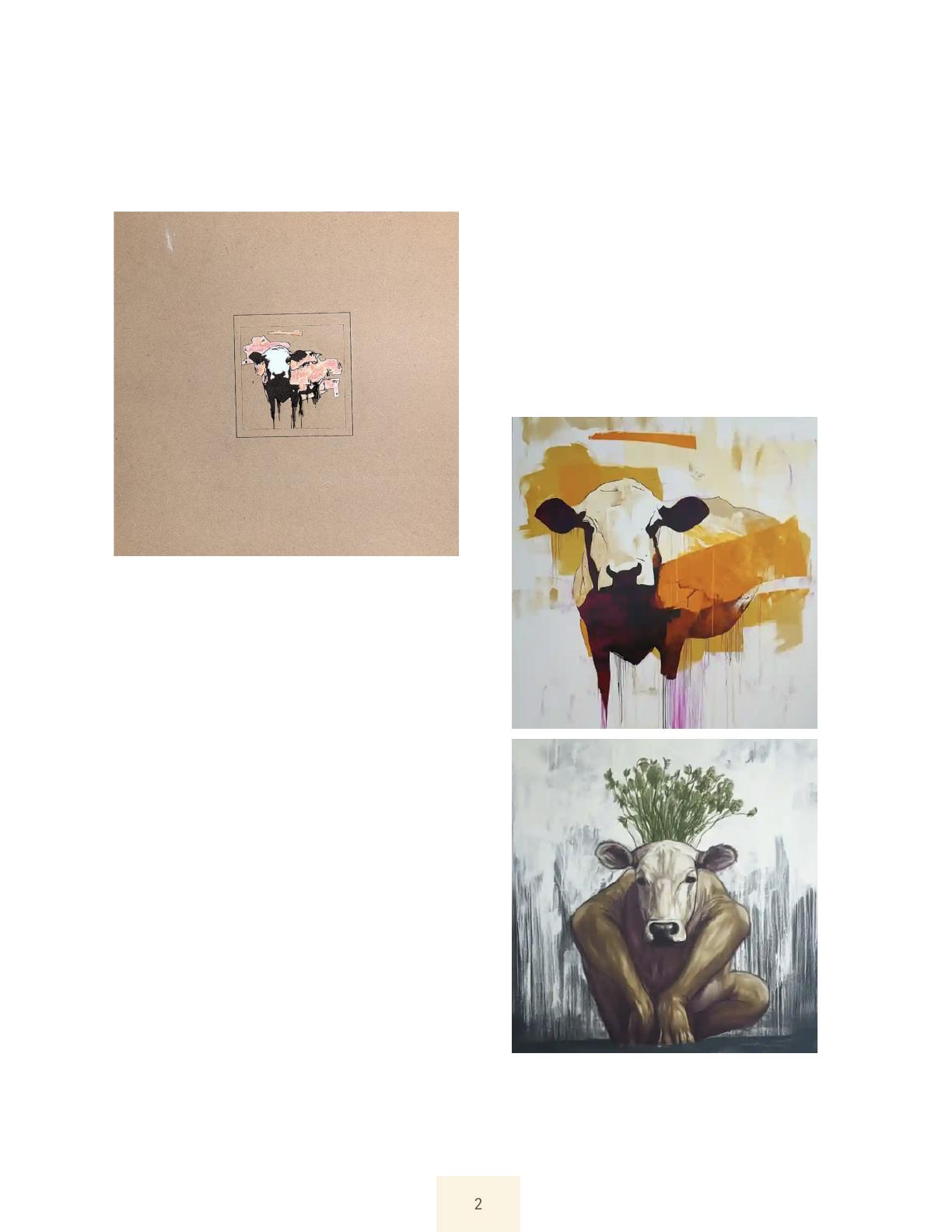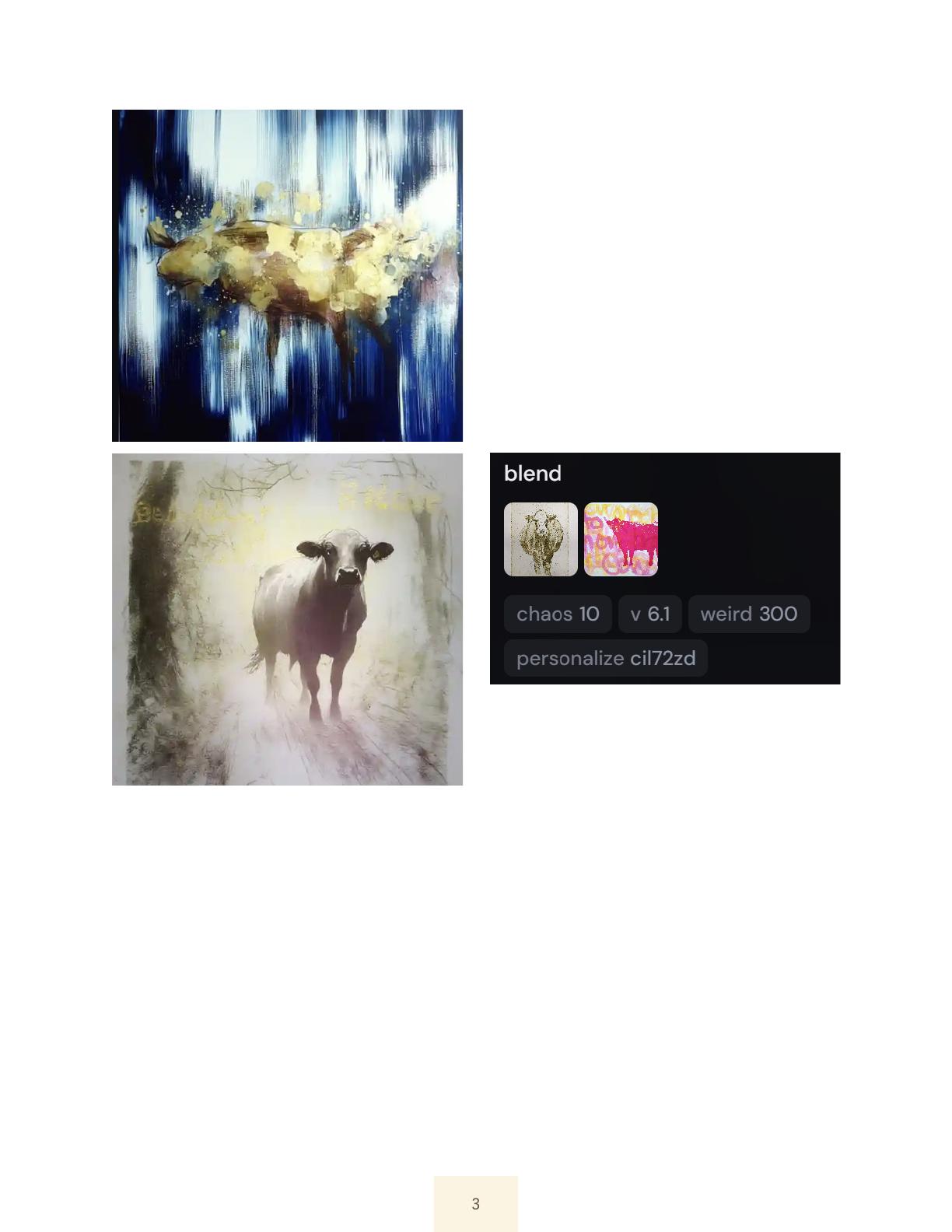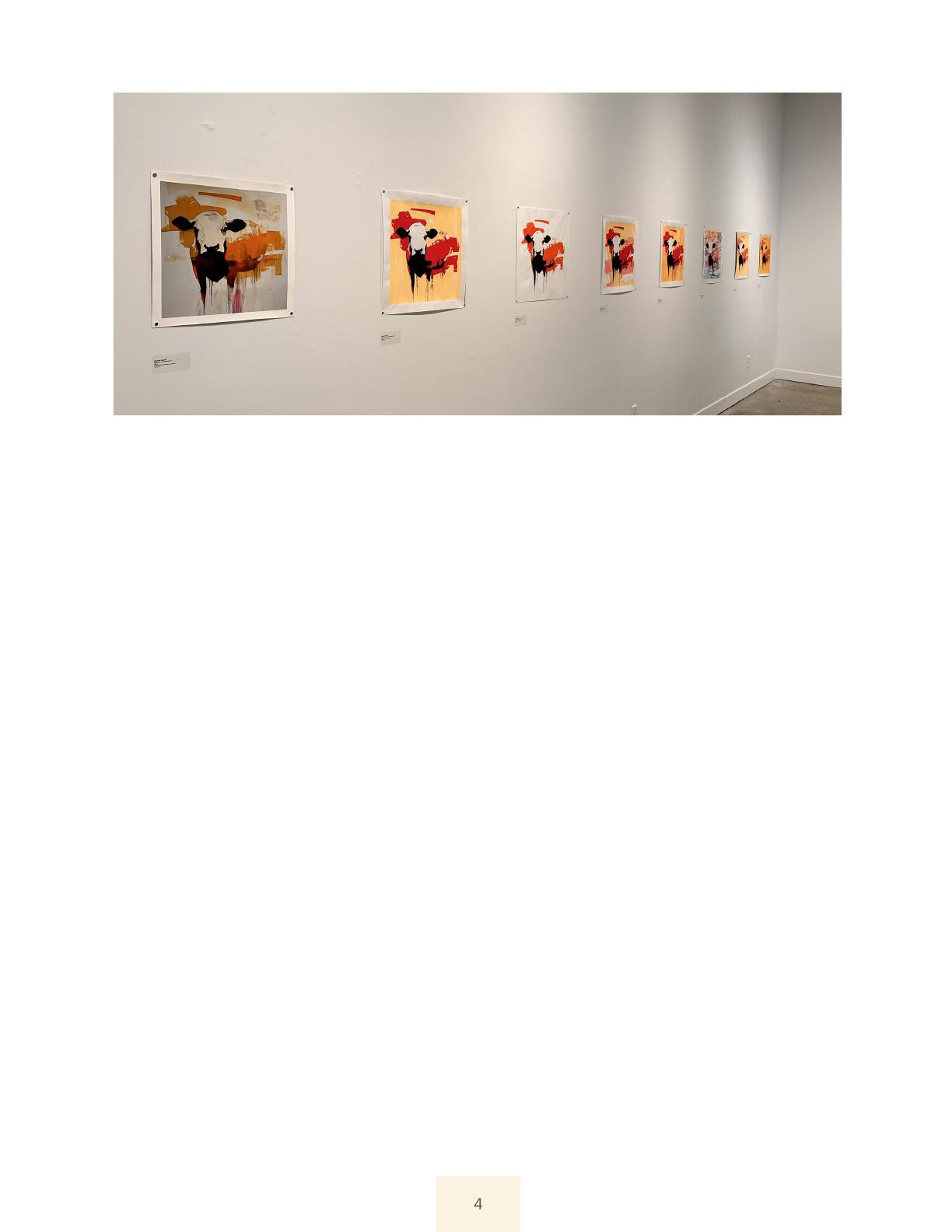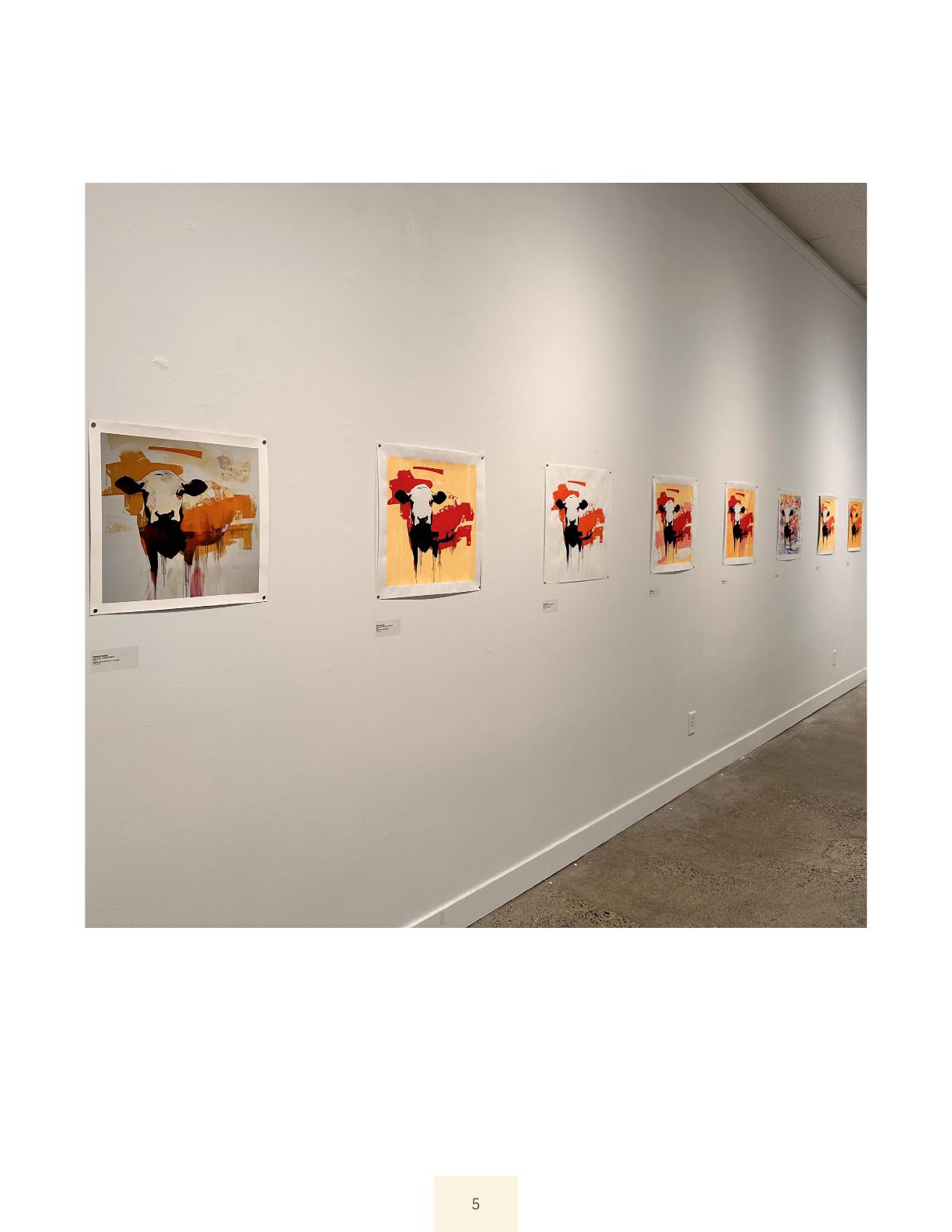
1
ISSN: XXXX-XXXX SPECIAL ISSUE 2025
This work is licensed under an Aribution-NonCommercial-NoDerivatives 4.0 International license.
This special issue of Future Earth Journal:
Explorations in Art and Generative AI showcases
the work of visual art students from the Fall 2024
Selected Topics visual art course Explorations in Art
and AI. Each featured artist engaged with genera-
tive artificial intelligence (Gen AI) to create original
artworks that respond to and reflect on current
conversations in art and technology. Through their
unique practices, these students explored Gen AI as
a tool, a collaborator, and/or a conceptual influence.
The artworks featured here—and in the exhibi-
tion held at the TRU Art Gallery from March 17–29,
2025—highlight the cultural, ethical, environmental,
and creative dimensions of using Gen AI in artistic
production.
Elizabeth Sigalet is one of the participating art-
ists whose work exemplifies this exploration.
AI Source: Midjourney
ARTIST STATEMENT
This project explores themes of juxtaposition,
blind spots, and contradictions using printmaking
techniques and AI-generated images. The primary
PINK COWS AND AI TO EXPLORE BLIND SPOTS AND
SOCIAL POLARIZATION
Elizabeth Sigalet
Bachelor of Fine Arts, Thompson Rivers University, 2019
Figure 1. Pink Cow AI Collaboration Iterations, by Elizabeth Sigalet (2024). Screenprint on Masa paper, 18" x 18" [each]. (Image credit:
Elizabeth Sigalet).

2
urban and rural communities. I am increasingly
concerned about this divide, especially regarding
resource extraction and climate adaptation. I notice
that both communities have blind spots—some-
times willful, sometimes well-intentioned—that can
hinder eective communication and collaborative
problem-solving. My art seeks to reflect this com-
plexity and promote curiosity and dialogue.
As a printmaker, I work primarily in intaglio
and screenprint, blending digital and hand-drawn
elements. The layered nature of printmaking allows
me to explore depth and texture, both in terms of ink
and meaning. With the assistance of AI, I can gener
-
ate numerous ideas and, perhaps, uncover my own
medium is screenprint, with variations of incorpo-
rating digital and hand-drawn elements. Midjourney
was used to generate unique images by blending my
own paintings and intaglio prints. These were used
as reference for manipulation in Adobe Photoshop
to create digital positives or files for laser printing.
ChatGPT was used to refine my concept and artist
statement considering my objectives and the visual
outcome.
My art practice oen revolves around the
recurring subject of cows. I use these animals as
an analogy for complex subjects or blind spots, and
sometimes simply because I enjoy depicting them—
particularly in pink. Through these images, I invite
viewers to explore themes of connection, com-
munication, and perspective between seemingly
disparate worlds. I chose two images that I felt were
representative of my work and gave Midjourney the
prompt to blend them using the personalization I
developed. I repeated this with slight variations to
the prompt generating over a hundred images that I
considered before choosing one image as reference
and for further manipulation.
Growing up with family members involved in
agriculture, forestry, and resource extraction, I have
witnessed firsthand the polarized divide between
Figure 2. Pink Cow AI Collaboration Iteration by Elizabeth
Sigalet. Laser cut MDF and acrylic paint.
(Image credit: Elizabeth Sigalet).
Figure 3. two of the artists original artworks which she
asked Midjourney to blend. (Image credit: Elizabeth
Sigalet).

3
playful, I hope they’ll feel encouraged
to explore other viewpoints and per-
haps recognize their own blind spots.
My journey has been shaped by my family
background, my upbringing on a ranch in British
Columbia, and my academic and professional life. I
am a wife, a mother of three, and a graduate of UBC
in Applied Science and Thompson Rivers University
in Fine Arts. With a career spanning engineering and
health protection, I am now a regional advocate for
professional artists. My experiences have taught
me the value of adaptability and resilience, and I am
acutely aware of the challenges faced by an older
female artist in a small, resource-based community.
Studying AI has broadened my perspective,
pushing me to challenge my own assumptions and
inviting others to do the same. I am curious about
how AI might help us confront our biases and pro-
mote nuanced discussions around pressing social
and climate issues. Over time, I have become more
mindful of creating art that fosters dicult but
necessary conversations. I believe that, through
respectful dialogue, we can find solutions that are
equitable and ethical, even when addressing con-
tentious topics.
Experimentation is central to my process,
especially when merging art with AI. The unpredict-
ability of AI oen generates unanticipated results,
sparking new paths of expression and helping me
to delve deeper into dicult ideas. My art is a space
where curiosity, caution, and boldness intersect a
space that encourages us all to see the world a lile
dierently.
biases or blind spots. The reproducibility inherent
in printmaking mirrors the iterative process of AI,
highlighting the themes of repetition and variation
that underpin my work.
Through my art, I hope viewers will
question the seemingly whimsical
choice of subject maer and consider
the broader implications. I want them
to reflect on their own perceptions,
to see the cow not only as a rural
emblem but as a symbol of perspec-
tives they might not fully understand.
By engaging with the unexpected and
Figure 4. Midjourney AI images generated from a blend of the
Artist’s original artwork (prompt and original artwork images
shown in Figure 5)
Figure 5. Command using the artist's original artworks in Mi-
djourney AI to generate images (Image credit: Elizabeth Sigalet)

4
Figure 5. Exhibit Installation of multiple Pink Cow AI Collaboration Iterations. (Photo credit: Twyla Exner)
Process
Elizabeth used MidJourney’s “blend” function
to generate new artworks using her original art as
references. In Figure 3, there are two of her origi-
nal artworks which she asked Midjourney to blend.
Figure 4 are Midjourney’s blends of the two works.
She chose to focus on the orange cow to create
screen prints. She printed multiple iterations of her
screen prints. Iterations produced in the screen
prints are intended to reference iterations produced
by AI. No two prints are exactly the same.
Upcoming Presentation
Elizabeth will present this project at the
IMPACT Internation Conference Series, hosted
by the Centre for Print Research in Trois-Rivières,
Quebec, in October 2025.

5
Exhibit Installation of multiple Pink Cow AI Collaboration Iterations. by Elizabeth Sigalet (Image credit:
Twyla Exner)
